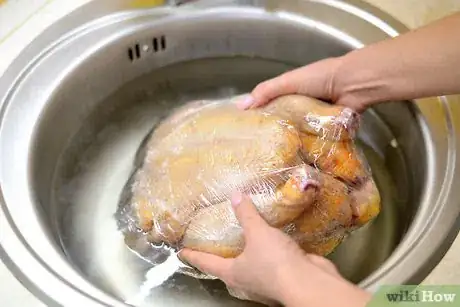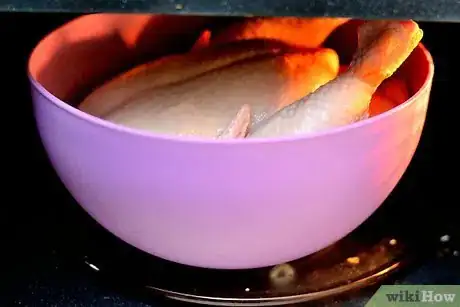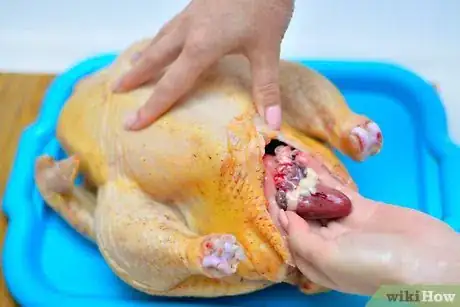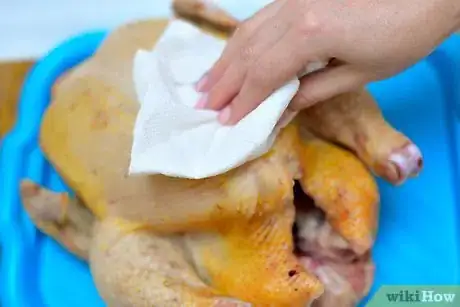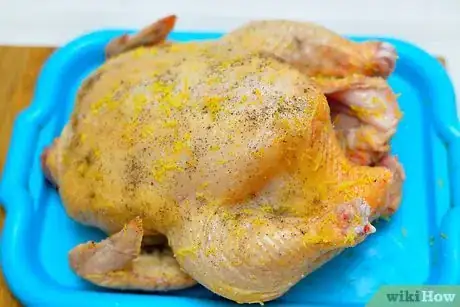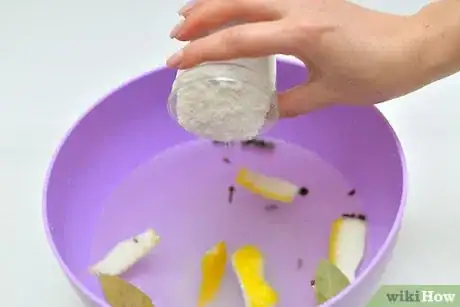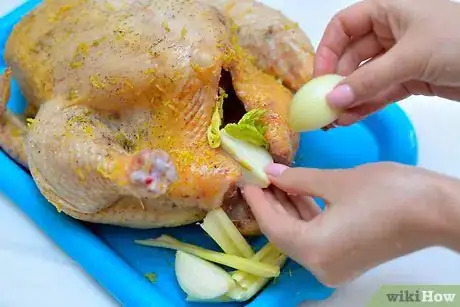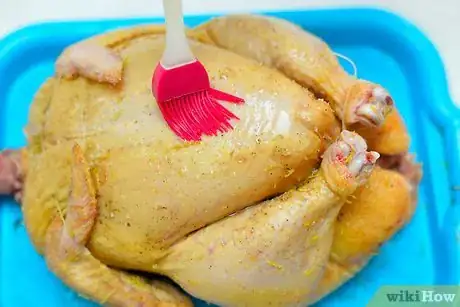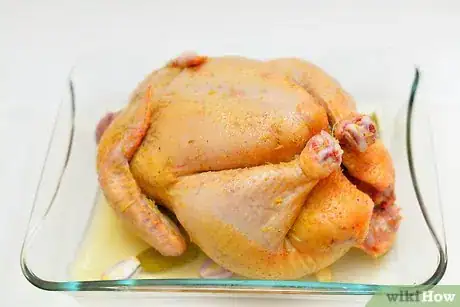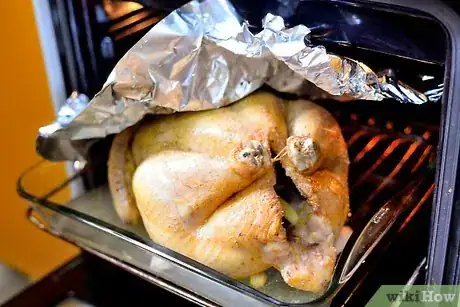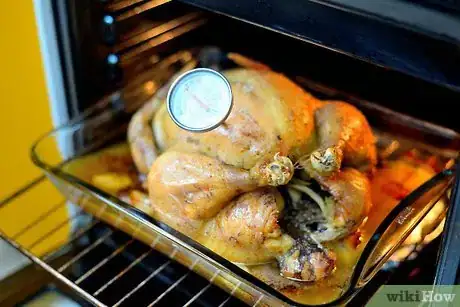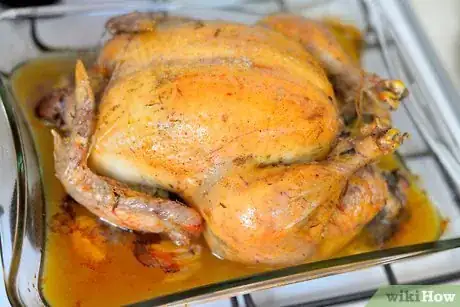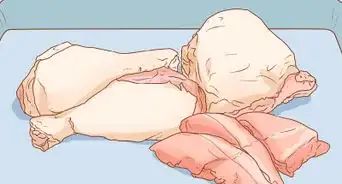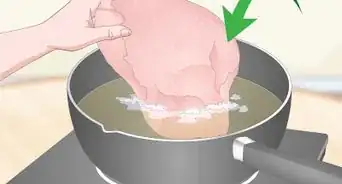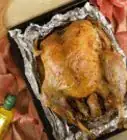This article was co-authored by Alex Hong. Alex Hong is the Executive Chef and Co-Owner of Sorrel, a New American restaurant in San Francisco. He has been working in restaurants for over ten years. Alex is a graduate of the Culinary Institute of America, and has worked in the kitchens of Jean-Georges and Quince, both Michelin-starred restaurants.
wikiHow marks an article as reader-approved once it receives enough positive feedback. In this case, 81% of readers who voted found the article helpful, earning it our reader-approved status.
This article has been viewed 488,085 times.
Whether you like your turkey basted or brined, white meat or dark meat, the secret to the perfect bird is in the roasting. It's easy to prepare and roast a turkey to feed your friends and family, even if you’re a new chef!
Ingredients
- 1 turkey
- 0.5 teaspoons (2.5 mL) of coarse kosher salt
- 1 tablespoon (15 mL) of black pepper
- 1 lemon, zested
- 6 garlic cloves, smashed and peeled
- 12 fluid ounces (350 mL) of hard apple cider
- 12 fluid ounces (350 mL) of dry white wine
- 1 onion, peeled and quartered
- 3 bay leaves
- 1 cup (240 mL) olive oil or melted butter
- 4 cups (950 mL) of scored bread (optional)
- 1 cup (240 mL) of chopped celery (optional)
- 1 chopped onion (optional)
Steps
Thawing Your Turkey
-
1Thaw the turkey in the fridge for 24 hours for every 5 pounds (2.3 kg). The USDA recommends this thawing method for cooking turkey because it’s safe and can be adjusted for any size bird. Be sure to allow for 24 hours of thawing for every 4 or 5 pounds (1.8 or 2.3 kg) of turkey.[1]
- If you’re worried about the turkey dripping as it defrosts, place it on a baking sheet to catch any water that might condense on the packaging.
- Avoid keeping the turkey in the refrigerator for longer than 48 hours after it is completely thawed, as this can cause the meat to go bad.
-
2Place the bird in water for 30 min per 1 lb (0.45 kg) for same-day thawing. Keep the turkey in its original wrapper, and submerge it in a bath of cold water in the sink or a large bowl. For example, if you have a 16 pounds (7.3 kg) turkey, it will need to thaw for 8 hours before you can cook it![2]
- To make sure the water stays cold and the turkey is at a safe temperature, replace the water every 30 minutes by draining the sink or emptying the bucket and putting in fresh, cold water.
Advertisement -
3Microwave the turkey for 6 min per 1 lb (0.45 kg) for quick defrosting. Unwrap your turkey and place it on a microwave-safe dish. The specific instructions for defrosting will depend on the weight of the turkey and the wattage of your microwave. While the turkey is in the microwave, make sure it’s rotating, and flip it over several times while defrosting. Once the turkey is thawed, cook it immediately.[3]
- Normally, you can find the information for thawing a turkey in the manual of the microwave or by searching for the brand of the microwave and the phrase “thawing turkey” online.
- If your turkey starts to cook instead of thawing, take it out of the microwave and let it rest for about 5 minutes before continuing with the thawing process.
Cleaning and Seasoning the Turkey
-
1Reach into the turkey to remove the giblets. If you bought your turkey from the store, there might be a package of innards or other organs inside of the turkey. Locate the cavities between the legs of the turkey and at the top of the turkey where the neck would be, and use your hand to grab and pull out everything that’s inside of the bird. You can set them aside for later.[4]
- Some people save the giblets for making a delicious giblet gravy to drizzle over the turkey.
- If you don’t want to eat these parts, you can discard them as soon as you remove them from the bird.
-
2Wipe the turkey with a dry paper towel to remove excess moisture. Sometimes, after thawing the turkey, it can appear wet. Grab a paper towel and blot the water off of the turkey before you season it to ensure that the seasoning sticks to the skin.[5]
- Any additional bacteria on the turkey will cook off during the roasting, so don’t worry about trying to get the bird completely clean.
- Avoid running water over the turkey or using a kitchen towel to clean it, as this can spread bacteria throughout your kitchen from drips or splashes of the contaminated water.
-
3Apply a dry brine for seasoned, crispy skin. For an easy dry brine, combine 0.5 teaspoons (2.5 mL) of kosher salt per 1 pound (0.45 kg) of turkey with 1 tablespoon (15 mL) of black pepper and the zest of a lemon. Then, rub the salt mixture all over the bird and let sit for at least an hour.[6]
- You can allow the brine to sit on the turkey for up to 2 days before cooking, and you can apply the brine even when the turkey is thawing.
- You can add extra black pepper or other seasonings to taste!
-
4Make a wet brine instead for moister skin. For a wet brine, place the turkey in a large pot, combine 0.5 teaspoons (2.5 mL) of kosher salt per 1 pound (0.45 kg) of turkey with 1 tablespoon (15 mL) of black pepper and the zest of a lemon, and fill the pot with water until the turkey is submerged.[7]
- As the turkey is marinating in the water and brine, place it in the refrigerator to keep the temperature at a safe level.
-
5Stuff the turkey if you want a savory side dish for the turkey. Stuffing is a bread mixture that can be cooked inside of the turkey to absorb the juices. To make the stuffing, simply mix 4 cups (950 mL) of scored bread, 1 cup (240 mL) of chopped celery, and 1 chopped onion together, and use your hands to completely fill the cavity of the turkey by packing the mixture into it.[8]
- Be aware that stuffing will add extra cook time to the recipe. Add an extra 30 minutes to the cook time if your turkey is stuffed.
-
6Truss the turkey to ensure evening cooking. Trussing is the process of using twine to tie the legs and wings to the turkey. It ensures that the turkey cooks evenly on all parts. To truss the bird, secure the wings to the turkey by wrapping baker’s twine around the body of the turkey, then cross the twine under the bottom of the bird. Finally, tie the legs together.[9]
- You can also truss a stuffed bird to keep the stuffing from coming out of the cavity while the turkey is in the roaster.
Cooking the Turkey
-
1Heat the oven to 450 °F (232 °C) while the turkey reaches room temperature. To properly roast a turkey, keep it in the kitchen for an hour to reach room temperature before you cook it. Place it on a dish or baking sheet out of the way while you preheat the oven and prepare the rest of the kitchen for cooking the turkey.[10]
- If you’re short on time, it’s acceptable to let the turkey sit for about 30 minutes to get it close to room temperature.
-
2Add hard apple cider and dry white wine to the bottom of the roasting pan. Fill the pan to a depth of about 0.25 inches (0.64 cm) with equal parts of the liquids. You should use about 12 fluid ounces (350 mL) of each liquid, depending on the size of your pan. Stir the cider and wine in the bottom of the pan with a spoon to make sure they’re evenly distributed.[11]
- This will add moisture and flavor to the meat while it’s cooking without making the skin too crispy.
-
3Place the onion, garlic cloves, and bay leaves into the liquid. Incorporating 1 quartered onion, 6 smashed and peeled cloves of garlic, and 3 bay leaves will add more flavor to the meat as it roasts. Mix them into the liquid with the spoon so that they’re evenly distributed on the bottom of the pan.[12]
- Some of the onion and garlic might stick out of the liquid. They’ll soften and incorporate into the juices as the turkey roasts.
-
4Brush the skin of the turkey with olive oil or butter. Apply enough oil or butter to completely coat the turkey, including the insides of the wings and legs and any small crevices. Depending on the size of the turkey, you will need around 1 cup (240 mL) of either oil or butter. You might need to slightly adjust the positioning of the turkey to get all of the skin.[13]
- Covering the turkey with a fat, like oil or butter, makes the skin crispy but not burnt. If you like moist skin on your turkey, apply less oil or butter.
-
5Place the turkey breast-side up on the roasting rack set inside of the pan. Be gentle when transferring the turkey to the pan. Try to avoid moving the turkey too much as this can cause the trussing to come undone or the stuffing to spill out.[14]
- It’s okay if the legs or side of the turkey touch the roasting pan.
-
6Add foil to the pan and lower the temperature to 350 °F (177 °C) after 30 minutes. Set a timer when the turkey is in the oven to remind you to cover it with foil after the first 30 minutes pass. Lowering the temperature and covering the turkey keeps the skin from burning and helps to cook the meat evenly.[15]
- Be careful when removing the turkey from the oven! Always use oven mitts and make sure you have enough space to place the roasting pan on the counter while you cover it with foil.
-
7Roast the turkey for 3 hours or until the internal temperature is 165 °F (74 °C). The cook time of the turkey will depend on how large it is, but the general rule is 20 minutes per 1 pound (0.45 kg). Insert the thermometer into the thickest part of the thigh of the turkey about 15 minutes before the end of the cook time to ensure that it’s cooked all the way through.[16]
- For example, if you have an unstuffed 10 to 18 lb (4.5 to 8.2 kg) turkey, plan on cooking for about 3.5-4 hours.
- Remember to add 30 minutes of extra cook time for a stuffed turkey.
-
8Remove the turkey from the oven and let it sit for 30 minutes before carving. When the turkey comes out of the oven, it will be extremely hot. It’s not safe to carve it at this temperature, so let it cool down a bit in the pan on the counter.[17]
- If you’re worried about the turkey getting too cold, keep it covered with the aluminum foil while it rests.
- You can let the turkey sit on the counter for up to an hour before carving while you make gravy or prepare other parts of your dinner!
-
9Finished.
Expert Q&A
Did you know you can get premium answers for this article?
Unlock premium answers by supporting wikiHow
-
QuestionHow do you keep a turkey moist when roasting?
 Alex HongAlex Hong is the Executive Chef and Co-Owner of Sorrel, a New American restaurant in San Francisco. He has been working in restaurants for over ten years. Alex is a graduate of the Culinary Institute of America, and has worked in the kitchens of Jean-Georges and Quince, both Michelin-starred restaurants.
Alex HongAlex Hong is the Executive Chef and Co-Owner of Sorrel, a New American restaurant in San Francisco. He has been working in restaurants for over ten years. Alex is a graduate of the Culinary Institute of America, and has worked in the kitchens of Jean-Georges and Quince, both Michelin-starred restaurants.
Executive Chef & Restaurant Owner To make the perfect bird, brine the whole turkey overnight. That really tenderizes the meat and makes it juicier. Then, give it about a day to dry out in the refrigerator. All the flavor and salt will still be in the flesh, but the skin will be able to get really crispy in the oven. Also, I like to put the turkey in a really hot oven, then bring the temperature back down to cook it low and slow.
To make the perfect bird, brine the whole turkey overnight. That really tenderizes the meat and makes it juicier. Then, give it about a day to dry out in the refrigerator. All the flavor and salt will still be in the flesh, but the skin will be able to get really crispy in the oven. Also, I like to put the turkey in a really hot oven, then bring the temperature back down to cook it low and slow. -
QuestionWhat’s the best temperature for roasting a turkey?
 wikiHow Staff EditorThis answer was written by one of our trained team of researchers who validated it for accuracy and comprehensiveness.
wikiHow Staff EditorThis answer was written by one of our trained team of researchers who validated it for accuracy and comprehensiveness.
Staff Answer wikiHow Staff EditorStaff Answer
wikiHow Staff EditorStaff Answer -
QuestionShould you cover your turkey with aluminum foil?
 wikiHow Staff EditorThis answer was written by one of our trained team of researchers who validated it for accuracy and comprehensiveness.
wikiHow Staff EditorThis answer was written by one of our trained team of researchers who validated it for accuracy and comprehensiveness.
Staff Answer wikiHow Staff EditorStaff AnswerCovering your turkey with foil for at least part of the baking process can help keep it from browning too much. Just make sure to uncover it during the last half hour or so of cooking to allow the skin to brown or crisp up a little. Alternatively, you can cover just the ends of the drumsticks and wing tips with foil, since these are the parts of the turkey that tend to overcook the fastest.
wikiHow Staff EditorStaff AnswerCovering your turkey with foil for at least part of the baking process can help keep it from browning too much. Just make sure to uncover it during the last half hour or so of cooking to allow the skin to brown or crisp up a little. Alternatively, you can cover just the ends of the drumsticks and wing tips with foil, since these are the parts of the turkey that tend to overcook the fastest.
Warnings
- Handle knives and other sharp kitchen tools with care.⧼thumbs_response⧽
- Always wear oven mitts when handling the hot pan as it comes out of the oven.⧼thumbs_response⧽
Things You’ll Need
- Stuffing (optional)
- Baker's twine
- Oven
- Roasting rack and pan
- Brush
- Aluminum foil
- Instant thermometer
References
- ↑ https://www.foodsafety.gov/blog/2016/11/defrost-turkey.html
- ↑ https://www.foodsafety.gov/blog/2016/11/defrost-turkey.html
- ↑ https://www.foodsafety.gov/blog/2016/11/defrost-turkey.html
- ↑ https://www.myfearlesskitchen.com/whats-that-stuff-inside-my-turkey/
- ↑ http://safefood.eu/Healthy-Eating/Food,-Diet-and-Health/Seasonal-Features/Christmas-tips-and-advice/Preparing,-stuffing-and-cooking-your-turkey.aspx
- ↑ https://cooking.nytimes.com/guides/13-how-to-cook-turkey
- ↑ https://cooking.nytimes.com/guides/13-how-to-cook-turkey
- ↑ http://safefood.eu/Healthy-Eating/Food,-Diet-and-Health/Seasonal-Features/Christmas-tips-and-advice/Preparing,-stuffing-and-cooking-your-turkey.aspx
- ↑ https://cooking.nytimes.com/guides/13-how-to-cook-turkey
- ↑ https://www.thekitchn.com/turkey-timing-tips-from-the-kitchn-213225
- ↑ https://cooking.nytimes.com/guides/13-how-to-cook-turkey
- ↑ https://cooking.nytimes.com/guides/13-how-to-cook-turkey
- ↑ https://cooking.nytimes.com/guides/13-how-to-cook-turkey
- ↑ https://cooking.nytimes.com/guides/13-how-to-cook-turkey
- ↑ https://cooking.nytimes.com/guides/13-how-to-cook-turkey
- ↑ https://cooking.nytimes.com/guides/13-how-to-cook-turkey
- ↑ https://www.thekitchn.com/turkey-timing-tips-from-the-kitchn-213225
About This Article
To roast a turkey, first preheat your oven to 325°F (165°C). While it’s preheating, remove the neck and giblets from inside of the turkey, and discard them or save them to make gravy with. Then, place the turkey breast-side up on a rack in a roasting pan. Rub softened butter over the skin, then season the turkey with salt and pepper. Next, pour 2 cups (475 milliliters) of turkey stock into the roasting pan, and cover the turkey with an aluminum foil tent. Place the turkey in the oven, and baste it every 30 minutes using the stock and drippings in the pan. Add more stock 1 cup (235 milliliters) at a time if needed. Let the turkey cook for about 15 minutes for every 1 pound (0.5 kilograms) of meat. Remove the aluminum foil for the last 30-45 minutes to allow the skin to crispen. To tell if the turkey is done, insert a meat thermometer into the thigh. It’s done when the thermometer reads 165°F(75°C). For advice on how to season a delicious turkey, read on!

